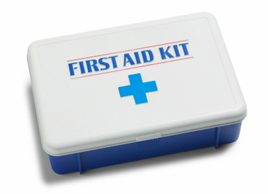6 summer safety tips you need to know
Whether you’re camping or cottaging, accidents can happen when you least expect them. Prepare yourself for challenges with these summer safety tips

Source: Web exclusive, June 2010
Summer is a great time to get outside, have fun and enjoy a wide range of activities, whether you’re camping, cottaging or hanging out by the pool. However, it’s also a time for prevention‘staying safe and protecting your family from summer-related injuries.
"In summer, we tend to let our guard down," says Shannon Koppenhoefer, an Ontario-based paramedic, who specializes in wilderness first-aid. "But the biggest way to stay safe is preparation."
First aid essentials
Being prepared for those common summer hazards’sunburns, insect bites and the occasional bump, bruise and scrape’starts with having the right attitude. "It’s not a case of ‘if’ something happens," says Koppenhoefer, “ask yourself ‘when it happens, how am I going to manage it?'”
The best thing that you can do is to have a well-stocked first-aid kit on hand. “Less than 20 percent of Canadians have a first-aid kit at their cottage,” says Koppenhoefer. While you can purchase a basic first-aid kit at your local store (think Walmart or Canadian Tire) Koppenhoefer suggests adding materials to it to make sure that you are well prepared in case of emergency.
Here’s what your first-aid kit should contain:
‘ Bandages and dressings
‘ Cloth tape
‘ Scissors
‘ Tweezers (a must for dealing with slivers)
‘ Polysporin
‘ Antihistamines (ie. Benadryl)
‘ Cold packs
‘ Insect repellant
‘ Sunscreen
‘ An index card with emergency contact numbers
"Most kits now come with gloves and breathing masks," adds Koppenhoefer. "All first-aid kits have a first aid book in them. Go through it with the whole family."
First-aid tips for kids
With kids spending so much time outdoors and away from the watchful eyes of parents in the summer, keeping them safe can be especially challenging. "When it comes to kids, they’re not in school, they’re outside and they’re not necessarily paying as much attention as they should," says Koppenhoefer. So it’s important to make sure that they’re aware of potential dangers and know how to keep themselves safe. “If they’re out running around in a field, be sure that they’re wearing long pants and close-toed shoes,” suggests Koppenhoefer. "They should also be wearing sunscreen and a sun hat."
For older kids who may be out exploring with friends all day, insist that they take along a water bottle, as well as a backpack stocked with snacks and a travel-sized first-aid kit.
Dealing with common summer health problems
Despite your best efforts, accidents may happen. Koppenhoefer has these tips for dealing with two of the most common’and often unavoidable’summer hazards.
1. Minor allergic reactions (mosquito bites, bee stings, poison ivy). "An easy solution to start is with soap and water," says Koppenhoefer. This will wash any lingering irritant from the skin. "Follow up with an antihistamine, which is going to take down the itch and turn off the reaction." If your child has a severe allergy, be sure to have an epi-pen on hand and make sure that they carry one with them if they are leaving your home.
2. Cuts, scrapes, bumps and bruises. "With cuts, the first step is to control the bleeding," says Koppenhoefer. "With minor cuts, you’ll again want to clean the area with soap and water. Then apply an antibiotic cream and finish with a bandaid to keep the area clean."
"The biggest element is to just be prepared," says Koppenhoefer. "A little preparation can help make the difference between an emergency a minor problem."
Don’t miss out! Sign up for our free weekly newsletters and get nutritious recipes, healthy weight-loss tips, easy ways to stay in shape and all the health news you need, delivered straight to your inbox.




